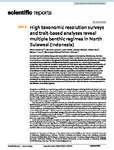High taxonomic resolution surveys and trait-based analyses reveal multiple benthic regimes in North Sulawesi (Indonesia)
| dc.contributor.author | Reverter, Miriam | |
| dc.contributor.author | Jackson, M | |
| dc.contributor.author | Rohde, S | |
| dc.contributor.author | Moeller, M | |
| dc.contributor.author | Bara, R | |
| dc.contributor.author | Lasut, MT | |
| dc.contributor.author | Segre Reinach, M | |
| dc.contributor.author | Schupp, PJ | |
| dc.date.accessioned | 2022-03-15T20:41:14Z | |
| dc.date.issued | 2021-08-16 | |
| dc.identifier.issn | 2045-2322 | |
| dc.identifier.issn | 2045-2322 | |
| dc.identifier.other | 16554 | |
| dc.identifier.uri | http://hdl.handle.net/10026.1/18948 | |
| dc.description.abstract |
As coral reef communities change and reorganise in response to increasing disturbances, there is a growing need for understanding species regimes and their contribution to ecosystem processes. Using a case study on coral reefs at the epicentre of tropical marine biodiversity (North Sulawesi, Indonesia), we explored how application of different biodiversity approaches (i.e., use of major taxonomic categories, high taxonomic resolution categories and trait-based approaches) affects the detection of distinct fish and benthic communities. Our results show that using major categories fails to identify distinct coral reef regimes. We also show that monitoring of only scleractinian coral communities is insufficient to detect different benthic regimes, especially communities dominated by non-coral organisms, and that all types of benthic organisms need to be considered. We have implemented the use of a trait-based approach to study the functional diversity of whole coral reef benthic assemblages, which allowed us to detect five different community regimes, only one of which was dominated by scleractinian corals. Furthermore, by the parallel study of benthic and fish communities we provide new insights into key processes and functions that might dominate or be compromised in the different community regimes. | |
| dc.format.extent | 16554- | |
| dc.format.medium | Electronic | |
| dc.language | en | |
| dc.language.iso | eng | |
| dc.publisher | Springer Science and Business Media LLC | |
| dc.title | High taxonomic resolution surveys and trait-based analyses reveal multiple benthic regimes in North Sulawesi (Indonesia) | |
| dc.type | journal-article | |
| dc.type | Journal Article | |
| dc.type | Research Support, Non-U.S. Gov't | |
| plymouth.author-url | https://www.webofscience.com/api/gateway?GWVersion=2&SrcApp=PARTNER_APP&SrcAuth=LinksAMR&KeyUT=WOS:000686663200051&DestLinkType=FullRecord&DestApp=ALL_WOS&UsrCustomerID=11bb513d99f797142bcfeffcc58ea008 | |
| plymouth.issue | 1 | |
| plymouth.volume | 11 | |
| plymouth.publication-status | Published online | |
| plymouth.journal | Scientific Reports | |
| dc.identifier.doi | 10.1038/s41598-021-95905-8 | |
| plymouth.organisational-group | /Plymouth | |
| plymouth.organisational-group | /Plymouth/Faculty of Science and Engineering | |
| plymouth.organisational-group | /Plymouth/Faculty of Science and Engineering/School of Biological and Marine Sciences | |
| plymouth.organisational-group | /Plymouth/Users by role | |
| plymouth.organisational-group | /Plymouth/Users by role/Academics | |
| dc.publisher.place | England | |
| dcterms.dateAccepted | 2021-07-29 | |
| dc.rights.embargodate | 2023-8-16 | |
| dc.identifier.eissn | 2045-2322 | |
| dc.rights.embargoperiod | Not known | |
| rioxxterms.versionofrecord | 10.1038/s41598-021-95905-8 | |
| rioxxterms.licenseref.uri | http://www.rioxx.net/licenses/all-rights-reserved | |
| rioxxterms.licenseref.startdate | 2021-08-16 | |
| rioxxterms.type | Journal Article/Review |


